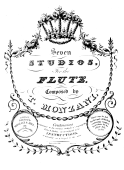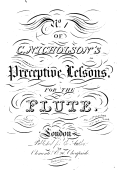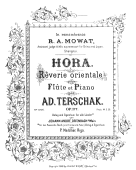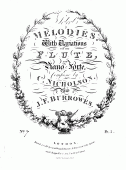







Unless otherwise stated, all items below are copies of 19th century manuscripts in my collection. These editions have been scanned and in some cases edited (blemishes removed) by Rick Wilson. Most were scanned in 2006.
They may be downloaded and printed for personal use. If links to these facsimiles are posted elsewhere, I would like an acknowledgement "Scanned by Rick Wilson" and a link to this website www.oldflutes.com .
[NEW, Oct., 2020] Part 2 of Eugène Walckiers' Méthode de Flûte, Op. 30, Paris, 1829. 121 pages, some difficult to read.
Rafael Dressler's New and Complete Instructions for the Flute, 1828. 59 pages. A good method for the beginner on the eight-or-more-key flute.
Tebaldo Monzani's Instructions for the German Flute, 3rd Edition, 1813. 68 pages, PDF file (12.2 MB). Includes many fingerings and explains how and when they are to be used. Also, Monzani's Seven Studies for the Flute. 30 pages, PDF file (6.8 MB). This is a sequel to the Instructions and illustrates the use of special and trill fingerings given there. Thanks to Joe Moir, who provided the manuscripts for copying.
Rudolf Tillmetz's Melodic Etudes, Op.47, for two flutes (c.1900). 39 pages, PDF file (4.9 MB). Contains extensive instructions on ornaments.
[NEW 2018] Ernesto Köhler's Flötenschule (Self Instructor for the Flute) (c.1880). Two volumes, 94 pages, PDF file (20 MB). Includes a fingering chart for flutes with 12 or more keys.
Four etudes from Volume 2 of Adolf Burose's Neue Grosse Flötenschule, c.1910. 25 pages, PDF file (4.66 MB). Shows the extended range required of the simple system flute at that time.
Victor Mahillon's Hints on the Fingering of the Boehm Flute, 1884. 20 pages, PDF file (2.5 MB). Extensive discussion of harmonics. [Re-scanned Auguest 1, 2006.]
Charles Nicholson's Preceptive Lessons for the Flute, London
(1821). Thanks to Joe Moir, from whose collection these were copied.
I recommend study of these strongly. Perhaps few of us would wish to
play in Nicholson's style, but his lessons help us to understand
some of the possibilities and potential of
the simple system flute. Lesson 1 (C major, A minor)
already illustrates Nicholson's interest in harmonic fingerings
as well as the glide and vibration. His ellaborate embellishments
and careful use of "marks of expression" are seen in his arrangement of
Aileen Aroon.
PDF files:
Number 1 (1.8 MB) —
Number 3 (1.0 MB) —
Number 4 (1.2 MB) —
Number 5 (1.3 MB) —
Number 6 (1.5 MB)
Charles Nicholson's Sure the Rose is like a Sigh
for flute and piano (c.1825).
PDF files:
flute part (300 KB);
score (1 MB).
Charles Nicholson's Le Bouquet, or Flowers of Melody
for one or two flutes (c.1820). Book 3 is missing most
of its pages, and Book 22 is missing two pages.
PDF files: Book 3 (1.7 MBB)
— Book 9 (3.4 MB)
— Book 21 (3.4 MB)
— Book 22 (2.9 MB)
Charles Nicholson's arrangment of Roslin Castle, 1821. Also includes Thomas Lindsay's version of Roslyn Castle.
Louis Drouët's variations on Roslin Castle, c.1830.
Drouët says that his variations are "Calculated for the
improvement of those who wish to acquire a proficiency in the
Art of Embellishing Melodies...".
PDF file of the flute part (620 KB).
NEW (2018) Paul Wetzger's Die Flöte: ihre Entstehung und Entwicklung bis zur Jetztzeit in akustischer, technischer u. musikalischer Beziehung, c1905. (84 pages, PDF)
